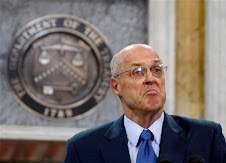November 14, 2008
Op-Ed Columnist
Depression Economics Returns
http://www.nytimes.com/2008/11/14/opinion/14krugman.html?_r=1&oref=slogin&pagewanted=print
 By PAUL KRUGMAN
By PAUL KRUGMANThe economic news, in case you haven’t noticed, keeps getting worse. Bad as it is, however, I don’t expect another Great Depression. In fact, we probably won’t see the unemployment rate match its post-Depression peak of 10.7 percent, reached in 1982 (although I wish I was sure about that).
We are already, however, well into the realm of what I call depression economics. By that I mean a state of affairs like that of the 1930s in which the usual tools of economic policy — above all, the Federal Reserve’s ability to pump up the economy by cutting interest rates — have lost all traction. When depression economics prevails, the usual rules of economic policy no longer apply: virtue becomes vice, caution is risky and prudence is folly.
To see what I’m talking about, consider the implications of the latest piece of terrible economic news: Thursday’s report on new claims for unemployment insurance, which have now passed the half-million mark. Bad as this report was, viewed in isolation it might not seem catastrophic. After all, it was in the same ballpark as numbers reached during the 2001 recession and the 1990-1991 recession, both of which ended up being relatively mild by historical standards (although in each case it took a long time before the job market recovered).
But on both of these earlier occasions the standard policy response to a weak economy — a cut in the federal funds rate, the interest rate most directly affected by Fed policy — was still available. Today, it isn’t: the effective federal funds rate (as opposed to the official target, which for technical reasons has become meaningless) has averaged less than 0.3 percent in recent days. Basically, there’s nothing left to cut.
And with no possibility of further interest rate cuts, there’s nothing to stop the economy’s downward momentum. Rising unemployment will lead to further cuts in consumer spending, which Best Buy warned this week has already suffered a “seismic” decline. Weak consumer spending will lead to cutbacks in business investment plans. And the weakening economy will lead to more job cuts, provoking a further cycle of contraction.
To pull us out of this downward spiral, the federal government will have to provide economic stimulus in the form of higher spending and greater aid to those in distress — and the stimulus plan won’t come soon enough or be strong enough unless politicians and economic officials are able to transcend several conventional prejudices.
One of these prejudices is the fear of red ink. In normal times, it’s good to worry about the budget deficit — and fiscal responsibility is a virtue we’ll need to relearn as soon as this crisis is past. When depression economics prevails, however, this virtue becomes a vice. F.D.R.’s premature attempt to balance the budget in 1937 almost destroyed the New Deal.
Another prejudice is the belief that policy should move cautiously. In normal times, this makes sense: you shouldn’t make big changes in policy until it’s clear they’re needed. Under current conditions, however, caution is risky, because big changes for the worse are already happening, and any delay in acting raises the chance of a deeper economic disaster. The policy response should be as well-crafted as possible, but time is of the essence.
Finally, in normal times modesty and prudence in policy goals are good things. Under current conditions, however, it’s much better to err on the side of doing too much than on the side of doing too little. The risk, if the stimulus plan turns out to be more than needed, is that the economy might overheat, leading to inflation — but the Federal Reserve can always head off that threat by raising interest rates. On the other hand, if the stimulus plan is too small there’s nothing the Fed can do to make up for the shortfall. So when depression economics prevails, prudence is folly.
What does all this say about economic policy in the near future? The Obama administration will almost certainly take office in the face of an economy looking even worse than it does now. Indeed, Goldman Sachs predicts that the unemployment rate, currently at 6.5 percent, will reach 8.5 percent by the end of next year.
All indications are that the new administration will offer a major stimulus package. My own back-of-the-envelope calculations say that the package should be huge, on the order of $600 billion.
So the question becomes, will the Obama people dare to propose something on that scale?
Let’s hope that the answer to that question is yes, that the new administration will indeed be that daring. For we’re now in a situation where it would be very dangerous to give in to conventional notions of prudence.






















 Delicious
Delicious Digg
Digg StumbleUpon
StumbleUpon Propeller
Propeller Reddit
Reddit Magnoliacom
Magnoliacom Newsvine
Newsvine Furl
Furl Facebook
Facebook Google
Google Yahoo
Yahoo Technorati
Technorati





